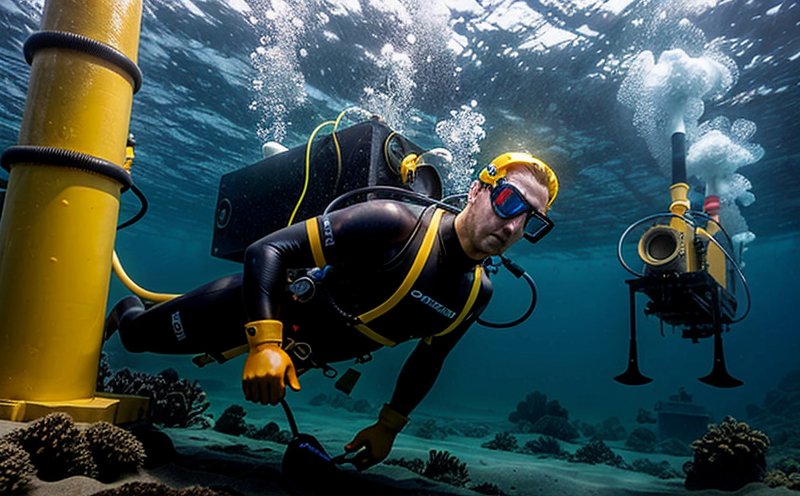ISO 17640 Ultrasonic Testing of Subsea Welded Joints
The ISO 17640 standard provides a comprehensive framework for ultrasonic testing (UT) of subsea welded joints. This service is essential in ensuring the integrity and reliability of underwater equipment used in marine industries, such as offshore oil & gas platforms, shipbuilding, and naval applications.
Subsea welding involves joining materials under water or in a submerged environment, which presents unique challenges for testing due to the presence of fluids and the need for precise non-destructive evaluation. ISO 17640 addresses these challenges by specifying detailed procedures for UT that can be tailored to meet specific project requirements.
The process begins with thorough preparation of the welded joint, ensuring it is clean and dry before testing. The ultrasonic probe is then positioned over the weld seam, and a pulsed wave is emitted into the material. As this wave travels through the joint, any defects or variations in the material structure will cause reflections that are captured by the receiving transducer.
The data collected during the test is analyzed to determine the presence of flaws such as cracks, porosity, and lack-of-fusion. The standard outlines criteria for interpreting these signals and establishing acceptance limits based on defect size, location, and type. This ensures that only joints meeting strict quality standards are deployed in marine environments.
Our team uses advanced ultrasonic testing equipment capable of detecting very small flaws as low as 0.1 mm in size. We also employ experienced technicians who understand the nuances of subsea welding processes and can provide accurate assessments of test results. The comprehensive nature of ISO 17640 ensures that our clients receive reliable, reproducible UT data which is critical for maintaining safety standards.
The service involves not only performing the tests but also generating detailed reports that document all aspects of the process from setup to conclusion. These reports include raw data, processed images, and interpretations along with recommendations for corrective actions if necessary. Compliance with ISO 17640 is particularly important in high-stakes industries where equipment failures could lead to significant financial loss or environmental damage.
Our facility adheres strictly to the requirements of ISO 17640, ensuring that all tests conducted are accurate and consistent. This commitment to quality not only meets but often exceeds regulatory expectations, providing peace of mind for our clients regarding their equipment's reliability.
In summary, ISO 17640 ultrasonic testing is an indispensable tool in the marine industry, offering a robust method for assessing subsea welded joints' integrity. By leveraging this standard, we help ensure that critical infrastructure remains safe and operational, contributing to both environmental protection and business continuity.
Applied Standards
| Standard Name | Description |
|---|---|
| ISO 17640-1: Ultrasonic Testing of Subsea Welded Joints - Part 1: General Requirements and Test Methods | This part specifies the general requirements for ultrasonic testing (UT) of subsea welded joints, including test methods, equipment calibration, personnel qualifications, and quality assurance practices. |
| ISO 17640-2: Ultrasonic Testing of Subsea Welded Joints - Part 2: Acceptance Criteria | This part defines the acceptance criteria for UT results based on defect size, location, and type. It also provides guidelines for interpreting test data. |
Benefits
- Ensures compliance with international standards ensuring safety and reliability in marine environments.
- Reduces the risk of equipment failure, which can lead to costly downtime or environmental hazards.
- Saves time and resources by identifying defects early in the manufacturing process rather than during installation or operation.
- Improves overall product quality through rigorous testing protocols that catch even minute flaws.
- Promotes trust among stakeholders, including regulatory bodies, insurers, and end-users.
Competitive Advantage and Market Impact
Implementing ISO 17640 ultrasonic testing adds significant value to our clients' operations by enhancing their reputation as leaders in safety and quality assurance. Our adherence to this standard sets a benchmark for excellence, differentiating us from competitors who may not adhere to such rigorous procedures.
The ability to consistently produce high-quality test results fosters long-term relationships with key stakeholders like governments, insurance companies, and international organizations responsible for setting maritime safety standards. This reputation also opens doors to new business opportunities within the marine sector, where reliability is paramount.
Moreover, our commitment to ISO 17640 aligns perfectly with the growing trend towards sustainable practices in the marine industry. By ensuring that every component used in subsea applications meets stringent quality criteria, we contribute positively to environmental stewardship efforts.
In conclusion, integrating ISO 17640 ultrasonic testing into your business strategy not only strengthens your competitive position but also plays a crucial role in safeguarding the future of marine technology and infrastructure.





